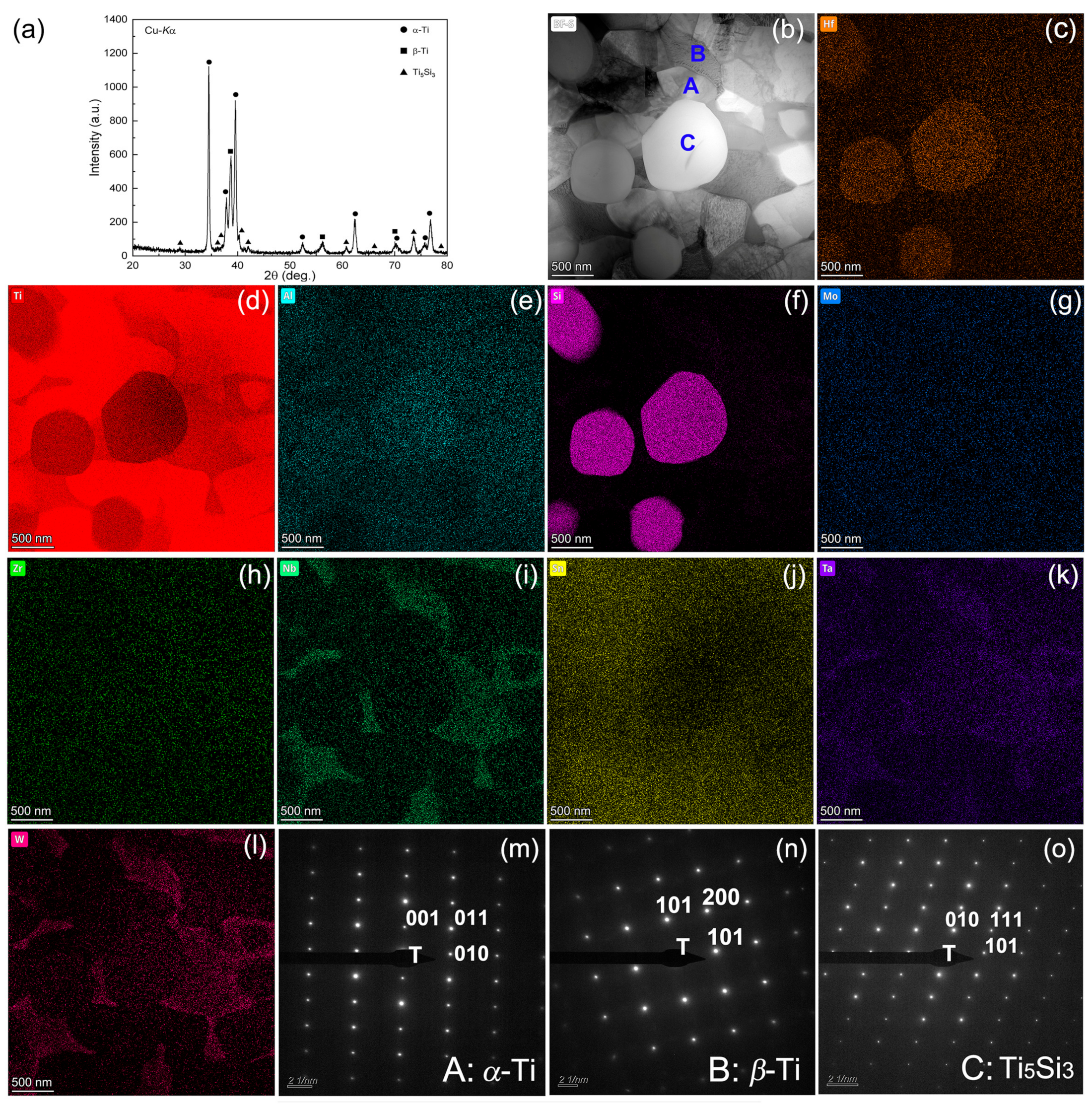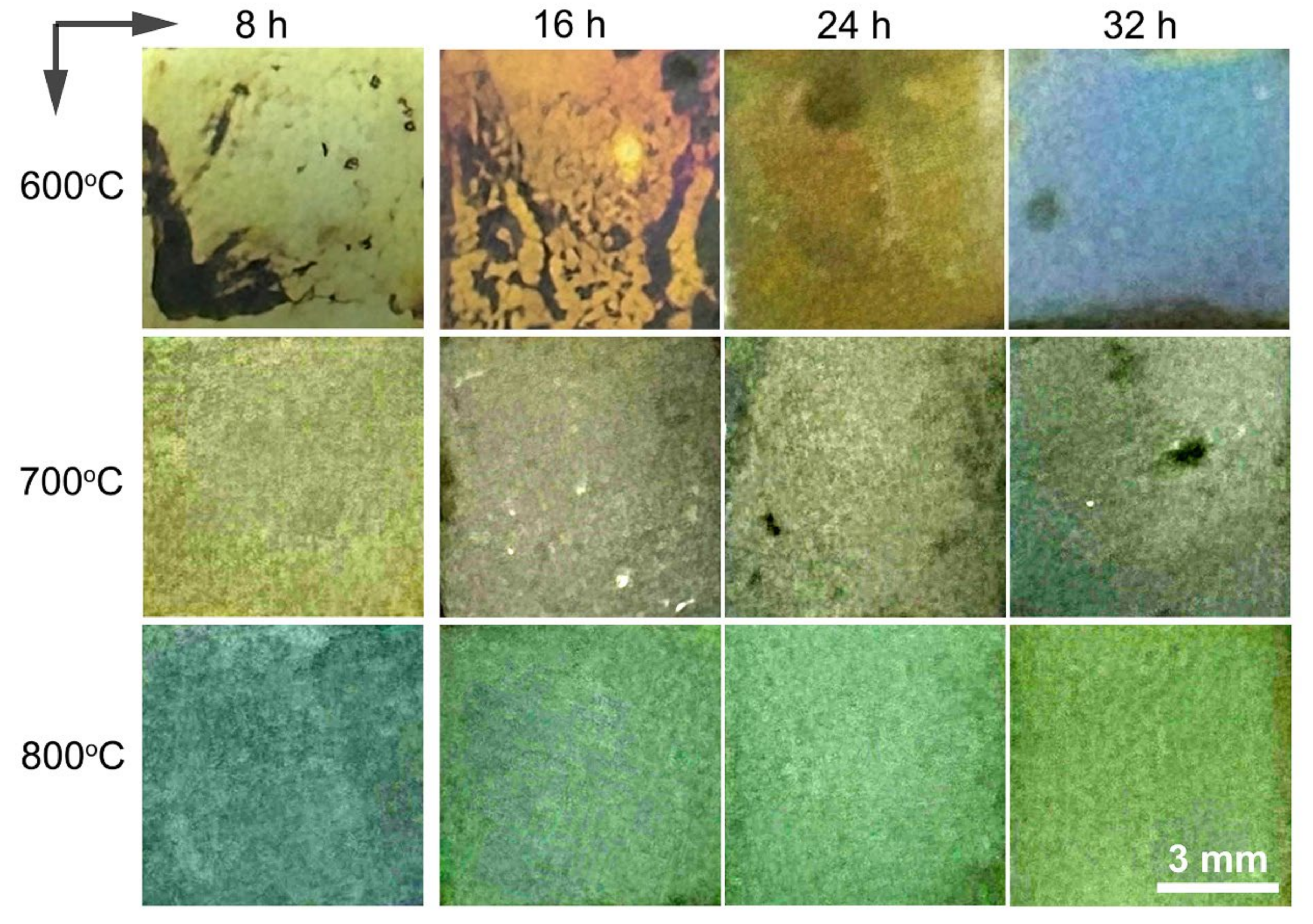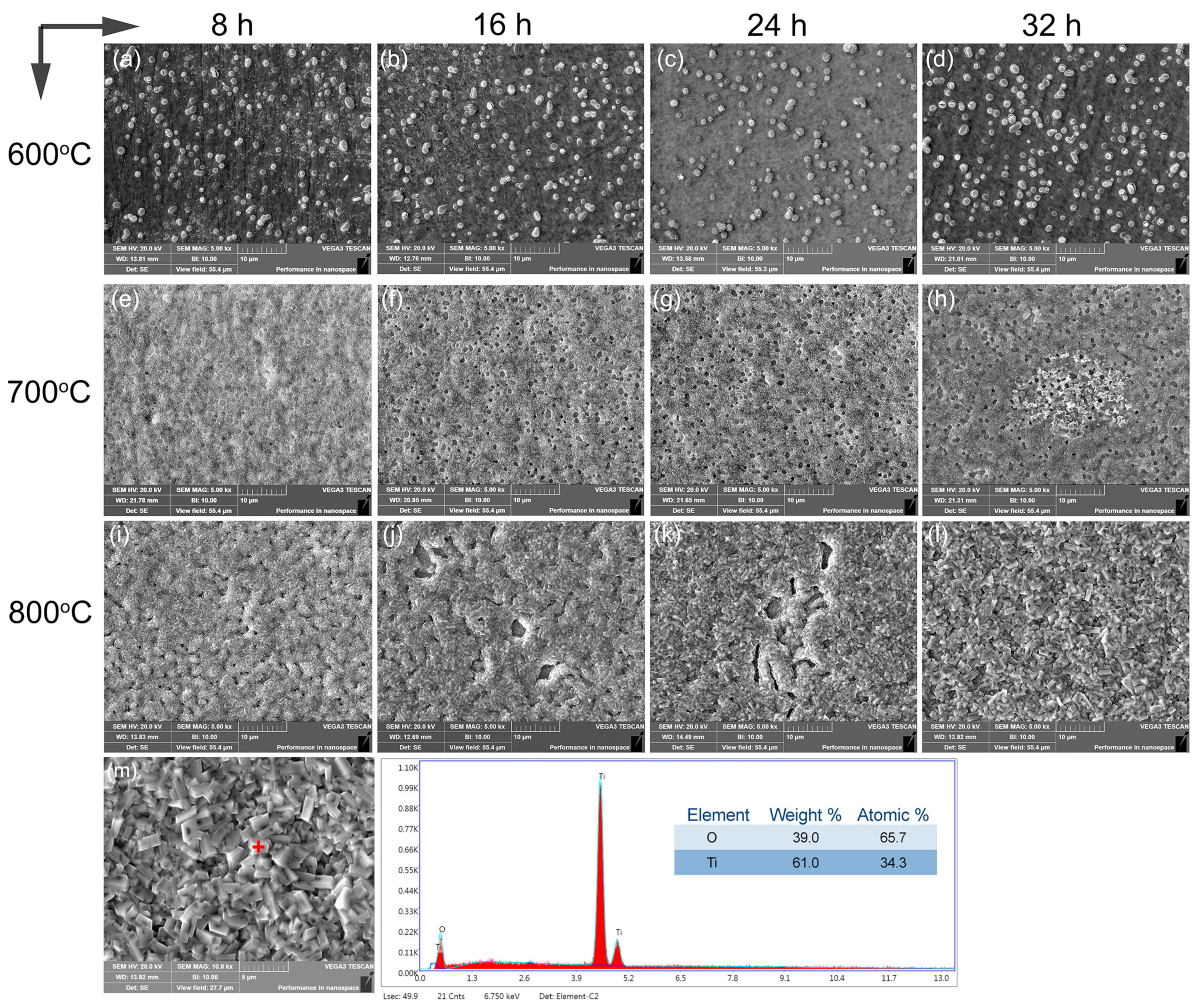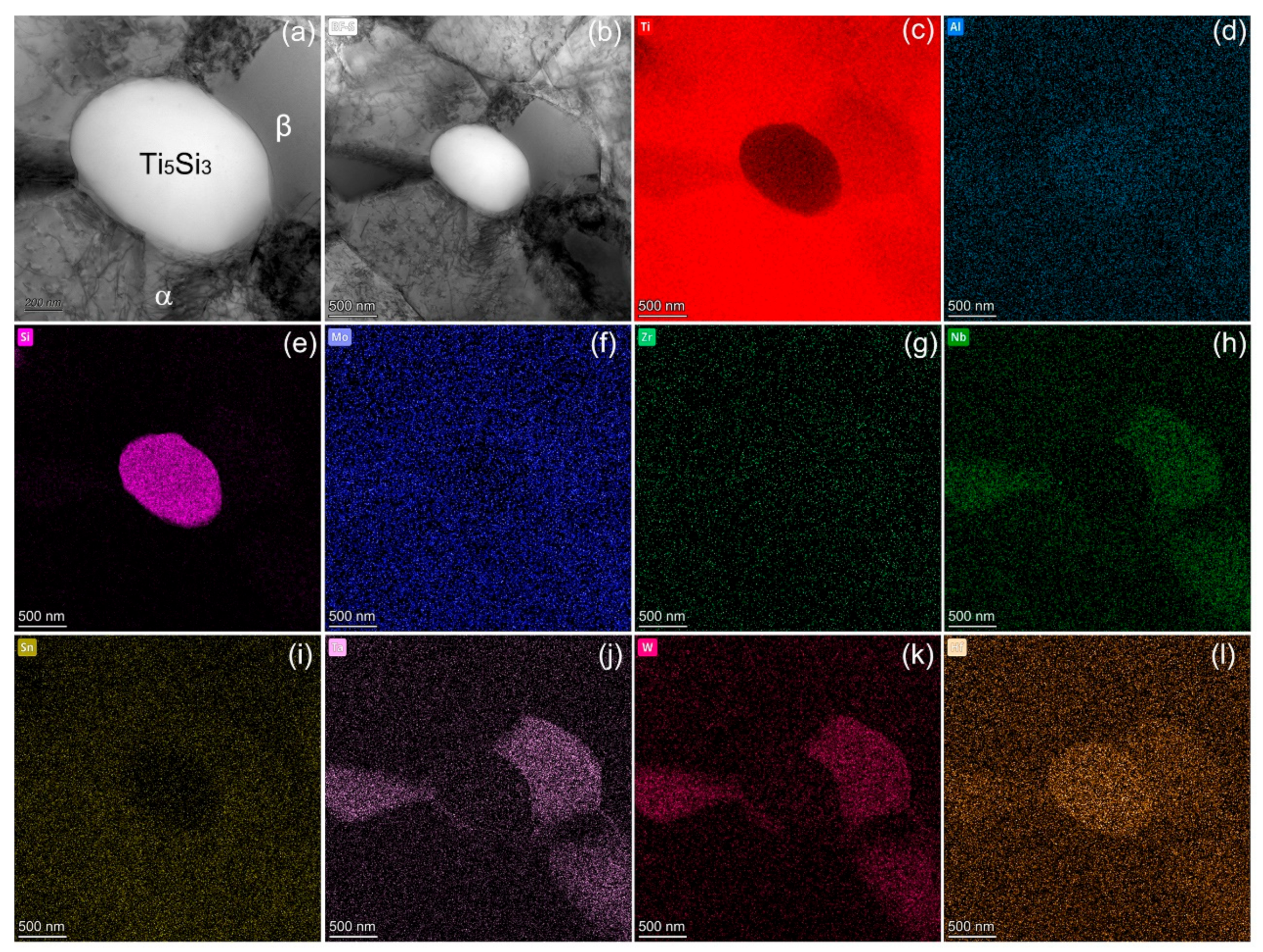Revealing High-Temperature Oxidation and Tensile Behaviors along with Underlying Mechanisms of a Titanium Alloy with Precipitated Titanium Silicide
Abstract
:1. Introduction
2. Materials and Methods
3. Results and Discussions
4. Conclusions
- The alloy showed excellent resistance to oxidation at 600 °C and 700 °C. An oxidation reaction index (n) close to 2 and a small parabolic rate constant indicated favorable oxidation resistance. At 700 °C, the n value of 2.32 suggested that a diffusion mechanism governed the oxidation process, ensuring effective protection by the oxide film.
- At 700 °C, the presence of oxidation-resistant Ti5Si3 particles at the phase boundaries hindered their full reaction with oxygen, acting as barriers to oxygen ingress. Conversely, at 800 °C, the oxidation was impacted by a strong interfacial reaction between oxygen and the oxide film/substrate. The resulting oxide film exhibited a porous structure with TiO2 rods and irregular pores, indicating a dramatic decline in oxidation resistance at an elevated temperature.
- The high temperature tensile data tested at 550 °C were σy = 227.54 MPa, σt = 305.4 MPa, ε = 107.7%; σy = 113.52 MPa, σt = 142.58 MPa, ε = 253.1% at 600 °C; σy = 42.41 MPa, σt = 54.11 MPa, ε = 694.7% at 650 °C. Notably, high deformations at 600 °C and 650 °C led to internal cracks in certain large Ti5Si3 particles; however, no interface debonding occurred due to the superior interface bonding strength with the matrix.
- Microstructural analysis post-deformation indicated the presence of a complex dislocation structure, primarily within the α-Ti phase. The increased deformation temperatures led to decreased intragranular and grain boundary strengths, with the grain boundaries becoming the weakest points in the alloy at 650 °C. The grain boundaries were prone to microcrack formation during high-temperature deformation due to their inherent weakness. In contrast, the interfaces between the Ti5Si3 precipitates and the matrix exhibited robust interfacial bonding strength.
Author Contributions
Funding
Institutional Review Board Statement
Informed Consent Statement
Data Availability Statement
Conflicts of Interest
References
- Yang, Y.; Zhang, Y.; Liu, X.; Zhang, H. Study on cavitation corrosion properties of titanium alloy radiation rod with different roughnesses for ultrasonic casting. Coatings 2023, 13, 1632. [Google Scholar] [CrossRef]
- Lu, W.J.; Zhuo, L.C. Additive manufacturing of titanium alloys via selective laser melting: Fabrication, microstructure, post-processing, performance and prospect. Int. J. Refract. Met. Hard. Mater. 2023, 111, 106110. [Google Scholar] [CrossRef]
- Lin, Y.; Wang, H.; Zhang, M.; Lin, H.; Yan, D.; Lin, Q.; Kang, X.; Wang, X. Gradient coating of laser cladding TiB2/Ti-based alloy on titanium alloy surface. Coatings 2023, 13, 743. [Google Scholar] [CrossRef]
- Graf, G.; Seyffertitz, M.; Spoerk-Erdely, P.; Clemens, H.; Stark, A.; Hatzenbichler, L. On the stability of Ti(Mn,Al)2C14 Laves phase in an intermetallic Ti–42Al–5Mn alloy. Intermetallics 2023, 161, 107962. [Google Scholar] [CrossRef]
- Pang, G.; Lin, Y.C.; Jiang, Y.; Zhang, X.; Liu, X.; Xiao, Y. Precipitation behaviors and orientation evolution mechanisms of α phases in Ti-55511 titanium alloy during heat treatment and subsequent hot deformation. Mater. Charact. 2020, 167, 110471. [Google Scholar] [CrossRef]
- Dai, J.; Zhu, J.; Chen, C.; Weng, F. High temperature oxidation behavior and research status of modifications on improving high temperature oxidation resistance of titanium alloys and titanium aluminides: A review. J. Alloys Compd. 2016, 685, 784–898. [Google Scholar] [CrossRef]
- Li, J.; Wang, L.; Qin, J.; Chen, Y.; Lu, W.; Zhang, D. Thermal stability of in situ synthesized (TiB+La2O3)/Ti composite. Mater. Sci. Eng. A 2011, 528, 4883–4887. [Google Scholar] [CrossRef]
- Li, J.; Wang, L.; Qin, J.; Chen, Y.; Lu, W.; Zhang, D. Effect of microstructure on high temperature properties of in situ synthesized (TiB+La2O3)/Ti composite. Mater. Charact. 2012, 66, 93–98. [Google Scholar] [CrossRef]
- Jiao, Y.; Huang, L.J.; Wei, S.L.; Geng, L.; Qian, M.F.; Yue, S. Nano-Ti5Si3 leading to enhancement of oxidation resistance. Corros. Sci. 2018, 140, 223–230. [Google Scholar] [CrossRef]
- Yin, X.; Liang, J.; Gao, Y.; Lin, Z.; Chen, S.; Liu, C. Effects of LaB6 on the high-temperature oxidation behavior of TiC + TiBx reinforced titanium matrix composite coatings fabricated by laser cladding. Surf. Coat. Technol. 2021, 421, 127445. [Google Scholar] [CrossRef]
- Xu, X.; Liu, Y.; Tabie, V.; Cai, C.; Xiao, Y.; Zhang, X. High-temperature oxidation resistance of a Ti-Al-Sn-Zr titanium matrix composites reinforced with in situ TiC and Ti5Si3 fabricated by powder metallurgy. Appl. Phys. A 2020, 126, 254. [Google Scholar] [CrossRef]
- Xiong, Y.; Du, M.; Zhang, F.; Saba, F.; Shang, C. Preparation and mechanical properties of titanium alloy matrix composites reinforced by Ti3AlC and TiC ceramic particulates. J. Alloys Compd. 2021, 886, 161216. [Google Scholar] [CrossRef]
- Jiao, Y.; Huang, L.J.; Wang, S.; Li, X.T.; An, Q.; Cui, X.P. Effects of first-scale TiBw on secondary-scale Ti5Si3 characteristics and mechanical properties of in-situ (Ti5Si3 + TiBw)/Ti6Al4V composites. J. Alloys Compd. 2017, 704, 269–281. [Google Scholar] [CrossRef]
- Hu, Z.; Cheng, X.; Li, S.; Zhang, H.; Wang, H.; Zhang, Z. Investigation on the microstructure, room and high temperature mechanical behaviors and strengthening mechanisms of the (TiB + TiC)/TC4 composites. J. Alloys Compd. 2017, 726, 240–253. [Google Scholar] [CrossRef]
- Qi, J.Q.; Chang, Y.; He, Y.Z.; Sui, Y.W.; Wei, F.X.; Meng, Q.K. Effect of Zr, Mo and TiC on microstructure and high-temperature tensile strength of cast titanium matrix composites. Mater. Des. 2016, 99, 421–426. [Google Scholar] [CrossRef]
- Wang, H.W.; Qi, J.Q.; Zou, C.M.; Zhu, D.D.; Wei, Z.J. High-temperature tensile strengths of in situ synthesized TiC/Ti-alloy composites. Mater. Sci. Eng. A 2012, 545, 209–213. [Google Scholar] [CrossRef]
- Yang, J.; Chen, Y.; Xiao, S.; Xu, L.; Wang, X.; Tian, J. High temperature tensile properties, deformation, and fracture behavior of a hybrid-reinforced titanium alloy composite. Mater. Sci. Eng. A 2020, 788, 139516. [Google Scholar] [CrossRef]
- Zhao, Q.Y.; Yang, F.; Torrens, R.; Bolzoni, L. Evaluation of the hot workability and deformation mechanisms for a metastable beta titanium alloy prepared from powder. Mater. Charact. 2019, 149, 226–238. [Google Scholar] [CrossRef]
- Pan, Y.; Li, W.; Lu, X.; Hayat, M.D.; Yin, L.; Song, W. Microstructure and tribological properties of titanium matrix composites reinforced with in situ synthesized TiC particles. Mater. Charact. 2020, 170, 110633. [Google Scholar] [CrossRef]
- Akman, F.; Khattari, Z.Y.; Kaçal, M.R.; Sayyed, M.I.; Afaneh, F. The radiation shielding features for some silicide, boride and oxide types ceramics. Radiat. Phys. Chem. 2019, 160, 9–14. [Google Scholar] [CrossRef]
- Jiao, Y.; Huang, L.J.; Wei, S.L.; Peng, H.X.; An, Q.; Jiang, S. Constructing two-scale network microstructure with nano-Ti5Si3 for superhigh creep resistance. J. Mater. Sci. Technol. 2019, 35, 1532–1542. [Google Scholar] [CrossRef]
- Tang, Z.; Williams, J.J.; Thom, A.J.; Akinc, M. High temperature oxidation behavior of Ti5Si3-based intermetallics. Intermetallics 2008, 16, 1118–1124. [Google Scholar] [CrossRef]
- Liu, C.; Huang, L.J.; Geng, L.; Jiao, Y.; Tang, A. In situ synthesis of (TiC + Ti3SiC2 + Ti5Si3)/Ti6Al4V composites with tailored two-scale architecture. Adv. Eng. Mater. 2015, 17, 933–941. [Google Scholar] [CrossRef]
- Huang, K.; Han, X. High-temperature oxidation properties of Ti-Hf-Mo-Ta-Nb-B composite coating deposited on Ti60 alloy with laser cladding. Coatings 2023, 13, 1646. [Google Scholar] [CrossRef]
- Lu, J.; Zhao, Y.; Du, Y.; Zhang, W.; Zhang, Y. Microstructure and mechanical properties of a novel titanium alloy with homogeneous (TiHf)5Si3 article-reinforcements. J. Alloys Compd. 2019, 778, 115–123. [Google Scholar] [CrossRef]
- Yang, Y.; Bewlay, B.P.; Chang, Y.A. Thermodynamic modeling of the Hf–Ti–Si ternary system. Intermetallics 2007, 15, 168–176. [Google Scholar] [CrossRef]
- Xu, Y.; Fu, Y.; Li, J.; Xiao, W.; Zhao, X.; Ma, C. Effects of tungsten addition on the microstructural stability and properties of Ti-6.5Al-2Sn-4Hf-2Nb-based high temperature titanium alloys. J. Mater. Sci. Technol. 2021, 93, 147–156. [Google Scholar] [CrossRef]
- Jiang, B.; Wen, D.; Wang, Q.; Che, J.; Dong, C.; Liaw, P.K. Design of near-α Ti alloys via a cluster formula approach and their high-temperature oxidation resistance. J. Mater. Sci. Technol. 2019, 35, 1008–1016. [Google Scholar] [CrossRef]
- Guo, W.; Wang, H.; Peng, P.; Song, B.; Zhang, H.; Shao, T. Effect of laser shock processing on oxidation resistance of laser additive manufactured Ti6Al4V titanium alloy. Corros. Sci. 2020, 170, 108655. [Google Scholar] [CrossRef]
- Dai, J.; Sun, C.; Wang, A.; Zhang, H.; Li, S.; Zhang, H. High temperature oxidation and hot corrosion behaviors of Ti2AlNb alloy at 923 K and 1023 K. Corros. Sci. 2021, 184, 109336. [Google Scholar] [CrossRef]
- Bhattacharya, S.K.; Sahara, R.; Narushima, T. Predicting the parabolic rate constants of high-temperature oxidation of Ti alloys using machine learning. Oxid. Met. 2020, 94, 205–218. [Google Scholar] [CrossRef]
- Lim, H.P.; Liew, W.Y.; Melvin, G.J.; Jiang, Z. A short review on the phase structures, oxidation kinetics, and mechanical properties of complex Ti-Al alloys. Materials 2021, 14, 1677. [Google Scholar] [CrossRef] [PubMed]
- Chen, C.; Chen, M.; Xie, L.; Gong, Z.; Ye, J. Numerical and experimental investigations of the hot stamping process for complex aircraft skin parts composed of TA32 high-temperature titanium alloy using an Arrhenius-type constitutive model. Int. J. Adv. Manufact. Technol. 2019, 103, 807–817. [Google Scholar] [CrossRef]
- Li, H.; Ding, Q.; Gu, Y.; Li, G.; Zhang, Y.; Zhang, Y. The initial oxidation behavior of uranium and uranium-titanium alloys in standing storage. Corros. Sci. 2020, 176, 108879. [Google Scholar] [CrossRef]
- Vaché, N.; Cadoret, Y.; Dod, B.; Monceau, D. Modeling the oxidation kinetics of titanium alloys: Review, method and application to Ti-64 and Ti-6242s alloys. Corros. Sci. 2021, 178, 109041. [Google Scholar] [CrossRef]
- Wang, T.; Wang, L.; Lu, Q.; Fan, Z. Changes in the esthetic, physical, and biological properties of a titanium alloy abutment treated by anodic oxidation. J. Prosthet. Dent. 2019, 121, 156–165. [Google Scholar] [CrossRef] [PubMed]
- Wu, B.; Xiong, S.; Guo, Y.; Chen, Y.; Huang, P.; Yang, B. Tooth-colored bioactive titanium alloy prepared with anodic oxidation method for dental implant application. Mater. Lett. 2019, 248, 134–137. [Google Scholar] [CrossRef]
- Bi, X.; Du, G.; Kalam, A.; Sun, D.; Yu, Y.; Su, Q. Tuning oxygen vacancy content in TiO2 nanoparticles to enhance the photocatalytic performance. Chem. Eng. Sci. 2021, 234, 116440. [Google Scholar] [CrossRef]
- Dwivedi, C.; Mohammad, T.; Kumar, V.; Dutta, V. Ti3+ and oxygen defects controlled colored TiO2 nanoparticles by continuous spray pyrolysis. Vacuum 2020, 182, 109612. [Google Scholar] [CrossRef]
- Chong, Y.; Poschmann, M.; Zhang, R.; Zhao, S.; Hooshmand, M.S.; Rothchild, E. Mechanistic basis of oxygen sensitivity in titanium. Sci. Adv. 2020, 6, c4060. [Google Scholar] [CrossRef]
- Li, C.; Huang, L.; Zhao, M.; Guo, S.; Li, J. Hot deformation behavior and mechanism of a new metastable β titanium alloy Ti-6Cr-5Mo-5V-4Al in single phase region. Mater. Sci. Eng. A 2021, 814, 141231. [Google Scholar] [CrossRef]
- Lei, J.; Zhu, W.; Chen, L.; Sun, Q.; Xiao, L.; Sun, J. Deformation behavior and microstructural evolution during the hot compression of Ti-5Al4Zr8Mo7V alloy. Mater. Today Commun. 2020, 23, 100873. [Google Scholar] [CrossRef]
- Ling, K.; Mo, W.; Deng, P.; Chen, J.; Luo, B.; Bai, Z. Hot deformation behavior and dynamic softening mechanisms of hot-extruded Al-Cu-Mg-Ag-Mn-Zr-Ti alloy. Mater. Today Commun. 2023, 34, 105300. [Google Scholar] [CrossRef]
- Ji, X.; Guo, B.; Jiang, F.; Yu, H.; Fu, D.; Teng, J. Accelerated flow softening and dynamic transformation of Ti-6Al-4V alloy in two-phase region during hot deformation via coarsening α grain. J. Mater. Sci. Technol. 2020, 36, 160–166. [Google Scholar] [CrossRef]
- Guo, B.; Semiatin, S.L.; Jonas, J.J. Dynamic transformation during the high temperature deformation of two-phase titanium alloys. Mater. Sci. Eng. A 2019, 761, 138047. [Google Scholar] [CrossRef]
- Roy, S.; Suwas, S. Orientation dependent spheroidization response and macro-zone formation during sub β-transus processing of Ti-6Al-4V alloy. Acta Mater. 2017, 134, 283–301. [Google Scholar] [CrossRef]
- Agrawal, P.; Karthikeyan, S.; Makineni, S.K.; Gault, B.; Banerjee, D. Dynamic strain aging in the intermediate temperature regime of near-α titanium alloy, IMI 834: Experimental and modeling. Acta Mater. 2022, 222, 117436. [Google Scholar] [CrossRef]
- Prasad, K.; Sarkar, R.; Ghosal, P.; Varma, V.K. The influence of dynamic strain aging on the low cycle fatigue behavior of near alpha titanium alloy IMI 834. Mater. Sci. Eng. A 2008, 494, 227–231. [Google Scholar] [CrossRef]
- Chang, X.; Qi, Y.; Chen, X.; Xie, Z.; Zhang, P.; Chen, G. Extra work hardening and activation of softening mechanisms induced by α-β interactions of a metastable-β Ti alloy during sub-transus processing. Mater. Sci. Eng. A 2023, 865, 144653. [Google Scholar] [CrossRef]
- Joseph, S.; Bantounas, I.; Lindley, T.C.; Dye, D. Slip transfer and deformation structures resulting from the low cycle fatigue of near-alpha titanium alloy Ti-6242Si. Int. J. Plast. 2018, 100, 90–103. [Google Scholar] [CrossRef]
- Wang, T.; Guo, H.; Wang, Y.; Peng, X.; Zhao, Y.; Yao, Z. The effect of microstructure on tensile properties, deformation mechanisms and fracture models of TG6 high temperature titanium alloy. Mater. Sci. Eng. A 2011, 528, 2370–2379. [Google Scholar] [CrossRef]
- Wei, S.; Zhu, G.; Tasan, C.C. Slip-twinning interdependent activation across phase boundaries: An in-situ investigation of a Ti-Al-V-Fe (α + β) alloy. Acta Mater. 2021, 206, 116520. [Google Scholar] [CrossRef]







Disclaimer/Publisher’s Note: The statements, opinions and data contained in all publications are solely those of the individual author(s) and contributor(s) and not of MDPI and/or the editor(s). MDPI and/or the editor(s) disclaim responsibility for any injury to people or property resulting from any ideas, methods, instructions or products referred to in the content. |
© 2023 by the authors. Licensee MDPI, Basel, Switzerland. This article is an open access article distributed under the terms and conditions of the Creative Commons Attribution (CC BY) license (https://creativecommons.org/licenses/by/4.0/).
Share and Cite
Lu, J.; Ji, K.; Zhuo, L.; Chen, B.; Shao, H.; Huo, W.; Zhao, Y. Revealing High-Temperature Oxidation and Tensile Behaviors along with Underlying Mechanisms of a Titanium Alloy with Precipitated Titanium Silicide. Coatings 2023, 13, 2020. https://doi.org/10.3390/coatings13122020
Lu J, Ji K, Zhuo L, Chen B, Shao H, Huo W, Zhao Y. Revealing High-Temperature Oxidation and Tensile Behaviors along with Underlying Mechanisms of a Titanium Alloy with Precipitated Titanium Silicide. Coatings. 2023; 13(12):2020. https://doi.org/10.3390/coatings13122020
Chicago/Turabian StyleLu, Jinwen, Kaile Ji, Longchao Zhuo, Bingqing Chen, Hui Shao, Wangtu Huo, and Yongqing Zhao. 2023. "Revealing High-Temperature Oxidation and Tensile Behaviors along with Underlying Mechanisms of a Titanium Alloy with Precipitated Titanium Silicide" Coatings 13, no. 12: 2020. https://doi.org/10.3390/coatings13122020
APA StyleLu, J., Ji, K., Zhuo, L., Chen, B., Shao, H., Huo, W., & Zhao, Y. (2023). Revealing High-Temperature Oxidation and Tensile Behaviors along with Underlying Mechanisms of a Titanium Alloy with Precipitated Titanium Silicide. Coatings, 13(12), 2020. https://doi.org/10.3390/coatings13122020






